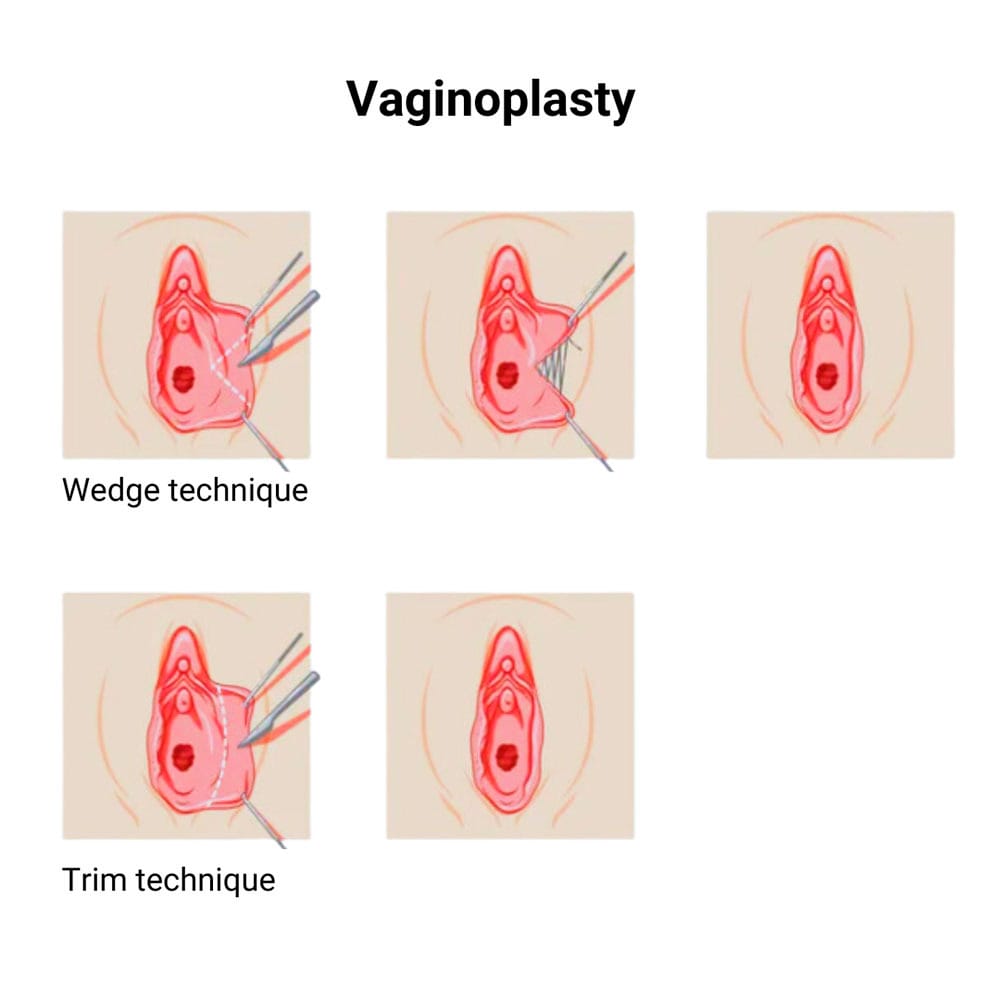What is a Vaginoplasty?
 A vaginoplasty, the technical term for vaginal reconstruction, is a surgical procedure to repair your vagina from damage due to medical issues, injuries or other reasons. It involves vaginal tightening surgery, and it’s also a type of gender-affirming surgery as it creates a vagina and vulva, and removes the penis, testicles and scrotum.
A vaginoplasty, the technical term for vaginal reconstruction, is a surgical procedure to repair your vagina from damage due to medical issues, injuries or other reasons. It involves vaginal tightening surgery, and it’s also a type of gender-affirming surgery as it creates a vagina and vulva, and removes the penis, testicles and scrotum.
Common types of vaginoplasty include:
- Reconstructive vaginoplasty that focuses on restoring function
- Cosmetic vaginoplasty, performed to enhance the appearance of the vagina
- Laser vaginoplasty, a technique done with lasers, which reduces recovery time and lowers risks as well
People choose to undergo a vaginoplasty for cosmetic as well as functional reasons, such as to treat urinary incontinence. If your doctor has recommended that you may benefit from a laser vaginoplasty, then choose a surgeon who’s at the top of the field. Dr Felix Cohen, founder and director of Cohen Medical Practice (CMP), has extensive training and performs a wide range of gynecological procedures.
His practice offers other vaginal and vulvar aesthetic procedures as well, such as:
Why Should I Consider Getting a Vaginoplasty?
It’s always a personal choice to decide whether you want it or not. Sometimes, it’s medically necessary; your CMP doctor may suggest it as a beneficial form of treatment.
Some scenarios in which you may be a good candidate or benefit from a vaginoplasty include:
- Restoring the vagina’s structure after childbirth
- Improving the appearance of your vagina for self-confidence
- Improving sexual function by tightening your vagina
- Affirming gender identity for transgender women
- Treating medical issues
- Repairing damage in your vagina due to trauma or previous surgery
Sometimes, after consulting with you or taking a medical history, your physician may advise you against a vaginoplasty. If you have any type of active infection in the pelvic area or vagina, your doctor doesn’t recommend this procedure.
Other common considerations that may preclude you from having this procedure include:
- Being post-menopausal
- Smoking and unable to quit
- Having structural issues that can’t be addressed with this procedure
What Happens During a Vaginoplasty?
The procedure depends on why you’re having the surgery. For both functional and aesthetic vaginal reconstruction, your physician has a detailed discussion with you about your expectations and possible outcomes.
The steps of a vaginal tightening surgery typically include:
- Receiving anesthesia, which can be general or local
- Making an incision around the vaginal opening for a functional vaginoplasty and removing excess tissue
- Fixing any damage you may have to the pelvic floor
- Reshaping the vaginal walls and tissues around it to enhance the function and restore the alignment
- Performing additional procedures during a cosmetic vaginal surgery, like labiaplasty
- Closing incisions with sutures, which may dissolve or require manual removal
For gender affirmation in transgender women, a vaginoplasty may be helpful as it creates a neo-vagina that aligns with your gender identity. A common method used involves inverting the penile tissues to form the vaginal canal. The surgeon sculpts the labia and forms a neo-clitoris. This process improves sexual function and appearance, which boosts confidence and self-esteem, allowing you to live more authentically.
What Is Vaginoplasty Recovery Like?
You’re monitored in the recovery area to ensure your vitals are stable. The surgery takes between two and five hours, depending on the case and your anatomy. The initial vaginoplasty recovery takes about six to eight weeks. Your physician might ask you to avoid sex after vaginoplasty for that time to allow proper healing.
Call your surgeon immediately if you see signs such as:
- Unmanageable pain
- Infection at the incision site
- Fever and chills
- Difficulty urinating
- Swelling in the vaginal area
Make sure you follow your surgeon’s post-op instructions, like using ice packs to reduce swelling. Keep the area clean and dry by using mild soap and water, and avoid using tampons and vaginal products. Avoid heavy physical activities for some time to ensure proper healing. You see significant results in the appearance of your vagina in three to six months. After one year, sensations should be back, and you can expect a full recovery with visible vaginoplasty results.
Are There Any Risks or Side Effects from a Vaginoplasty?
Like surgical procedures, a vaginoplasty has some potential risks and side effects. For some time, you might see swelling and bruising around the area, which goes down gradually. Some scarring is possible, but most of the time the surgeon works to minimize it as much as possible. Other side-effects like infection and problems urinating are greatly reduced when you rely on experts at Cohen Medical Practice (CMP).
Vaginal tightening surgery is a common procedure for the experienced team at New York City based CMP. If you think your life can improve after this surgery, then contact Dr. Cohen for a consultation. You don’t need to decide on surgery right away; after your consultation, he can guide you in the most effective treatment to meet your goals so you can make an informed decision.

